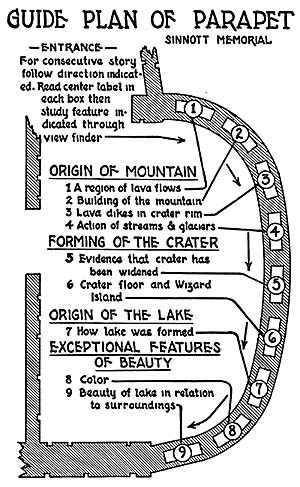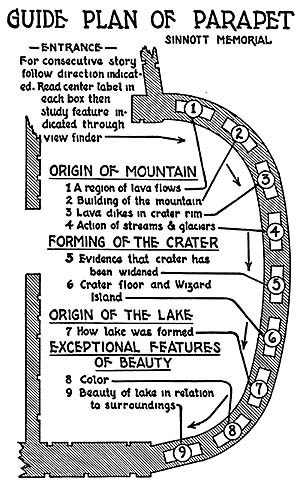A Brief Guide to the Parapet View, Sinnott Memorial, Crater Lake National Park by John Campbell Merriam, 1938

Origin of the Mountain
John Campbell Merriam (October 20, 1869 – October 30, 1945) was an American paleontologist, educator, and conservationist. The first vertebrate paleontologist on the West Coast of the United States, he is best known for his taxonomy of vertebrate fossils at the La Brea Tar Pits in Los Angeles, particularly with the genus Smilodon, more commonly known as the sabertooth cat. He is also known for his work to extend the reach of the National Park Service and work in preserving Coastal Redwoods in California.
View 1: This mountain is Part of a Tremendous Series of Lava Flows
 Numerous volcanoes in this lava region represent relatively late outpourings of melted rock through small openings. They have contributed only an extremely small part to the total mass of lava. The mountain at Crater Lake is one of these volcanoes. In late geological ages enormous flows of molten rock poured out over an area of more than 200,000 square miles, extending into Oregon, Washington, Montana, Idaho, Nevada, and California. These masses of lava came to the surface largely through great fissures in the earth. A typical section of such extensive flows is shown in the lava beds forming Columbia River Gorge.
Numerous volcanoes in this lava region represent relatively late outpourings of melted rock through small openings. They have contributed only an extremely small part to the total mass of lava. The mountain at Crater Lake is one of these volcanoes. In late geological ages enormous flows of molten rock poured out over an area of more than 200,000 square miles, extending into Oregon, Washington, Montana, Idaho, Nevada, and California. These masses of lava came to the surface largely through great fissures in the earth. A typical section of such extensive flows is shown in the lava beds forming Columbia River Gorge.
View 2: Building of the Mountain
 Two sections of the mountain are shown by finders to the right and left of this box. The one to the right is Dutton Cliff, made up of successive layers of lava and volcanic ash; the one to the left, near Discovery Point, shows a series of layers consisting of lava, volcanic ash, and glacial deposits. Specimens of the rock from each of these sections are shown in this box. Both localities may be reached by trail.The mountain in which Crater Lake rests was built by lava flows, poured out layer upon layer, and the piling up of volcanic ash, soil, deposits of streams flowing down the mountain, and materials carried by glaciers.
Two sections of the mountain are shown by finders to the right and left of this box. The one to the right is Dutton Cliff, made up of successive layers of lava and volcanic ash; the one to the left, near Discovery Point, shows a series of layers consisting of lava, volcanic ash, and glacial deposits. Specimens of the rock from each of these sections are shown in this box. Both localities may be reached by trail.The mountain in which Crater Lake rests was built by lava flows, poured out layer upon layer, and the piling up of volcanic ash, soil, deposits of streams flowing down the mountain, and materials carried by glaciers.
One can understand Crater Lake in its relation to the volcano only when the mountain is considered as result of construction extending over a long period, in which many changes took place.
View 3: Lava Outpourings Through Splitting of Crater Rim
 Devil’s Backbone, seen through the finder at this box, is an illustration of alava dike.In addition to spilling out as broad flows of melted rock, it is common for the tremendous mass of molten lava in a volcano to break through the mountain side. The lava filling of such a crack or fissure is known as a dike. After it cools the material filling these fissures is often harder than the surrounding rock. Subsequent wash of water may cut away the softer bordering material, leaving the hard filling of the fissure as a sharp ridge.
Devil’s Backbone, seen through the finder at this box, is an illustration of alava dike.In addition to spilling out as broad flows of melted rock, it is common for the tremendous mass of molten lava in a volcano to break through the mountain side. The lava filling of such a crack or fissure is known as a dike. After it cools the material filling these fissures is often harder than the surrounding rock. Subsequent wash of water may cut away the softer bordering material, leaving the hard filling of the fissure as a sharp ridge.
A diagram of the mountain in this box points out other radiating fissures or dikes. Specimens of these lavas are also shown.
View 4: Action of Streams and Glaciers on the Mountain in the Courses of Its Building
 The finder at the left of this box is directed toward a heavily polished and scratched rock surface on the edge of the crater. This type of wear is known to be produced by slow movement of ice carrying sand, pebbles, and boulders. Glacial polish and thick beds of material carried by glaciers are common around the mountain. They are present on the surface rock and seem also to appear between earlier layers, showing that glaciers were present at various stages in the history of the mountain.In the section of layers forming the rim of the mountain there are evidences of wash by water. In some places this is shown by cutting of valleys; at others by accumulation of water-carried ash, gravel, and boulders.
The finder at the left of this box is directed toward a heavily polished and scratched rock surface on the edge of the crater. This type of wear is known to be produced by slow movement of ice carrying sand, pebbles, and boulders. Glacial polish and thick beds of material carried by glaciers are common around the mountain. They are present on the surface rock and seem also to appear between earlier layers, showing that glaciers were present at various stages in the history of the mountain.In the section of layers forming the rim of the mountain there are evidences of wash by water. In some places this is shown by cutting of valleys; at others by accumulation of water-carried ash, gravel, and boulders.
Leaflet prepared by a committee of the National Academy of Sciences and the Carnegie Institution of Washington as an aid to the visitor. 8 pp. Washington: Carnegie Institution of Washington, 1933.
Broad valleys cut at various points around the crater are characteristic of glacial action. Kerr Notch is such an evidence of glacial erosion. It was through a similar ancient glacial notch that the lava at Llao Rock flowed out, as shown in the finder to the right of this box.
View 5: Broken Edges of Layers on Crater Slopes Indicate Widening of Crater in All Directions by Breaking Away of Walls
 If the activity of a volcano diminishes slowly, growth of the mountain may end in forming a symmetrical cone. If activity continues by spasmodic outbursts, explosions may blow away a considerable part of the peak. Other conditions may bring about undermining of the walls in such manner as to produce a wide cauldron-like crater, but without tremendous explosions.The edges of rock layers inside the crater wall are clearly exposed because they have been sharply broken around the entire rim region. This fracturing took place in course of widening the crater. Increase in size of the opening at the summit of the mountain may have been caused by tremendous explosions, or by collapse of the peak, or by combination of such activities. The precise nature of the story is not yet fully known.
If the activity of a volcano diminishes slowly, growth of the mountain may end in forming a symmetrical cone. If activity continues by spasmodic outbursts, explosions may blow away a considerable part of the peak. Other conditions may bring about undermining of the walls in such manner as to produce a wide cauldron-like crater, but without tremendous explosions.The edges of rock layers inside the crater wall are clearly exposed because they have been sharply broken around the entire rim region. This fracturing took place in course of widening the crater. Increase in size of the opening at the summit of the mountain may have been caused by tremendous explosions, or by collapse of the peak, or by combination of such activities. The precise nature of the story is not yet fully known.
View 6: Latest Stage in Forming in the Crater Lake, Eruptions Producing Wizard Island and Two Other Cones
 If the lake were removed the crater would be seen as a relatively flat-floored cavity extending as a maximum about 2,000 feet below the present lake surface. In this great depression Wizard Island would appear as one of three small volcanic cones produced by pouring out of lava and cinders in the last period of volcanic activity. Forming of the present floor probably involved many stages, during some of which the cauldron-like crater may have been occupied by wide stretches of molten lava, as in the “lake of fire,” at Kilauea, in Hawaii.
If the lake were removed the crater would be seen as a relatively flat-floored cavity extending as a maximum about 2,000 feet below the present lake surface. In this great depression Wizard Island would appear as one of three small volcanic cones produced by pouring out of lava and cinders in the last period of volcanic activity. Forming of the present floor probably involved many stages, during some of which the cauldron-like crater may have been occupied by wide stretches of molten lava, as in the “lake of fire,” at Kilauea, in Hawaii.
View 7
The water of Crater Lake is derived from rainfall and snowfall over this crater region, together with snow blown into the depression. The lake is not known to have outlet except by seepage. The conditions of evaporation, seepage, and precipitation are in a state of balance which makes possible this accumulation of water and maintenance of approximately this water level. If the region were at a different altitude, or in a different location, the lake might not have been formed.
It is conceivable that in the course of late stages in its history, and under climatic conditions different from those of the present, the crater may at times have been filled in part with ice.
Existence of Crater Lake was made possible by building of a mountain, in the elevated summit of which there could be formed a wide and deep cavity having no outlet, except by seepage, and no inlet. The conditions required for accumulation of a body of water with the peculiar beauty of this lake are furnished in a crater produced by combination of those tremendous forces found in the power and heat of a volcano.
View 8: Color an Outstanding Character of Crater Lake
 The deep blue of the lake is believed to be caused chiefly by the scattering of light in water of exceptional depth and clearness. The color is thought to be due to the same cause that produces blue of the sky where light passes through deep atmosphere.The color of Crater Lake is generally recognized as the most attractive feature of this region. Among spectacular lakes of the world there are none in which depth of color and brilliance of blue are more striking. The blue of the deeper water is brought out in contrast with the brilliant green of shallow areas along the margin.
The deep blue of the lake is believed to be caused chiefly by the scattering of light in water of exceptional depth and clearness. The color is thought to be due to the same cause that produces blue of the sky where light passes through deep atmosphere.The color of Crater Lake is generally recognized as the most attractive feature of this region. Among spectacular lakes of the world there are none in which depth of color and brilliance of blue are more striking. The blue of the deeper water is brought out in contrast with the brilliant green of shallow areas along the margin.
The extraordinary beauty of the lake arises in part from its great depth, clearness of the water and of the atmosphere above it, and from favorable conditions presented in viewing it from the high crater rim.
View 9: Beauty of the Lake in Relation to Its Surroundings
 1. Beauty of color in the lake as seen through the screen of hemlocks from the path leading to Sinnott Memorial, and similarly as seen through trees at many points along the rim.A thing of beauty may have its value enhanced by the setting in which it appears; so the attractiveness of this lake varies according to conditions under which it is seen. In the same way the beauty of other things may be increased by relation to the lake. Of many possible examples illustrating relation between the lake and its surroundings the following have been found of interest to visitors:
1. Beauty of color in the lake as seen through the screen of hemlocks from the path leading to Sinnott Memorial, and similarly as seen through trees at many points along the rim.A thing of beauty may have its value enhanced by the setting in which it appears; so the attractiveness of this lake varies according to conditions under which it is seen. In the same way the beauty of other things may be increased by relation to the lake. Of many possible examples illustrating relation between the lake and its surroundings the following have been found of interest to visitors:
2. Form and reflection of Phantom Ship seen through the finder next this box. Smooth reflecting surface of the water is necessary.
3. Continuous changes of light produce a constantly varying picture. These conditions may be due to position of the sun, to the wind, and to reflections and shadows of clouds.
4. Reflections of cliffs and other shore features.
Other pages in this section


